Water Feature
Our front yard now has a brand new pond and I am very proud of having built it myself so we're taking a little diversion from chickens for today. I started off reading a lot of things on the internet and there is so much conflicting information that I thought I would share how I built our pond in case you would like to replicate it yourself.
Step 1: First dig yourself a good hole. I had a look at pond liners that were available first and knew that I could get one that is 2.5x2m for $39, so that meant that I wanted to keep my pond less than 1.5x1m and no more than 50cm deep. You can use a garden hose to work out your approximate shape.
You want to dig the sides straight down, but be careful that you don’t break off parts of the wall as we want them nice and solid for later. You might want to start a little smaller than your ideal size and make it bigger as you go just incase you do accidentally collapse part of a wall. One point to realise is that once you have put on the rocks at the end it will seem smaller so don’t be afraid if it looks really big right now.
Take off the crumbly top soil to a width of 4-5 inches around the hole if this is an issue for you like it is for me. The top soil for us was only about an inch thick, which gives us a solid foundation for the bricks. Use a straight plank of wood and a spirit level to make sure your sides are reasonably in line across the pond. Use a hand trowel to shave off a little more if some areas are higher than others.
Pond Hole
Create a deep part and a shallow part in your pond. The centre of my hole is about 15cm deeper than the small area at the top. This will allow us to put in a range of plants as we desire. Some plants can only be placed in up to 20cm of water, some like it a lot deeper. Think about the fish you are going to get when you are planning your size as well as Koi need a much deeper, larger area than other fish.
Check for rocks and roots that may puncture your liner. After scraping with the shovel and removing most of the rocks I used my hands to feel around all the areas of the pond and dug out any more small rocks with the trowel.
Step 2: Place your underlay in the hole. I used about an inch of sand in the bottom and on the ledge. You can also use damp newspaper, carpet or special underlay that you can buy from garden centres.
Step 3: Lay your liner over the hole. Try not to drag the liner around too much, but with a little draping and patience, you can achieve a neat look with your liner. I took off my shoes and spent some time pushing it gently into all the corners and doing some initial pleating. You may want to use some black vinyl duct tape to tape down some of the pleats like I did to make them even less noticeable. Use bricks or stones to hold the liner down neatly all around the pond.
Pond Liner
Step 4: This is the step that most instructions jump straight to, though after my first attempt I took the extra time at step 3. Start to fill the pond with water until it is about half full. As it is filling you can gently ease out the liner at any areas where you need to allow more liner to reach the bottom or fix up any pleats.
When you are happy with the liner (take your time and get it right!) place your layer of bricks around the ledge. The purpose of the bricks is so that you will be able to have the water level above the liner so you will not notice it is there. There is nothing more distracting from a pond than seeing the ugly creases in a black plastic pond liner as per our first try, dubbed "Fail Pond".
Half Fill with Water
Step 5: If you are planning on having a pump or water feature, you will want to think about its placement and where the power cables and any other hoses will go at this point. We decided to have a simple water feature, so I placed the pump in the desired position and ran the cord to the side of the pond. I did not run the cord to the back because you don’t want to be looking at the cord when you are standing in front of the pond. The cord runs to the bottom of the photo below and then around the bricks until it comes out the back where you can see the cable (click it for a larger image) as this is the closest point to the house. Test the water feature! It is better to ensure it works now than have to take half of the pond apart to get it back out!
An optional step at this point is to fill any gaps between the bricks with quick setting cement. I used this between each brick so that any dirt or sand packed behind would be less likely to run into the pond when it is full of water. You do not need to make it waterproof as the pond liner takes care of this. Allow your cement to cure for 3-4 hours before proceeding.
Next gently ease the liner straight up behind the bricks and pack dirt up to it like a ramp, then fold the liner down and pack dirt over top. You can see in the photo that the liner comes up to the level of the bricks and then is hidden and slopes away from the pond. This should mean I won’t get a run off (including dirt) flowing into the pond, and any overflow will flow away from it.
Setup Pump and Backfill
Note also that we decided to have a “wetland” area for our pond. At the top of the photo there is a semi-circle of sand where the liner continues flat at the level of the bottom of the bricks under the sand, and then is built up in a mound. The sand area will be constantly wet allowing us to grow plants that like wet feet, but do not like to be submerged. You could do this too, or skip this part for a simple pond.
Step 6: Gently ease your rocks onto the sides and where possible, allow them to overlap the bricks completely. This step allows complete coverage of the pond liner and is the decorative part of the pond. It is handy to have a number of rocks to choose from so you can play with their positioning until you are happy with how it looks.
Position Rocks
Phew! Almost Done!
Great job!! Time you took a break!
Step 7: Waiting 24 hours gives the cement a chance to cure and your bricks and rocks a chance to settle into place. Top up the wetland with more sand as the rocks will hold that in place. Now it is time to fill up the pond until 1-2cm below the top of the bricks and add your plants. Wait at least 2 days before adding fish, or follow the recommendations from your local aquarium expert.
Complete with Plants
Turn on the fountain and Enjoy!

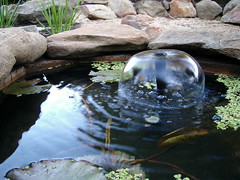
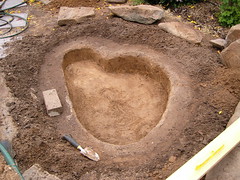
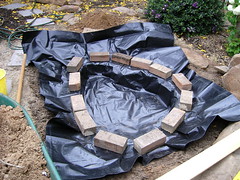
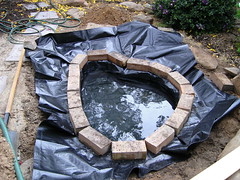
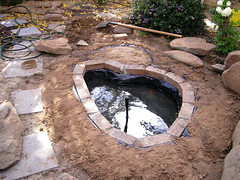
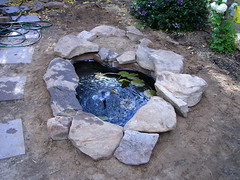
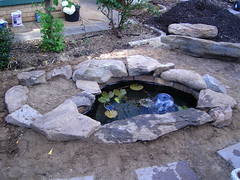
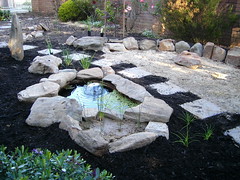
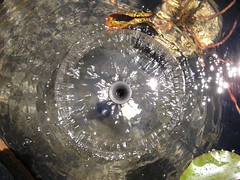



3 comments:
Needs more chickens. Put a chicken in the pond!
Needs more ducks. Put a duck in the pond!
I'll put YOU guys in the pond!
Post a Comment